|
|
| Line 167: |
Line 167: |
| | | | |
| | | | |
| | + | <center><math>\rightarrow \frac{dN_{scattered}}{t_{run}}=\frac{d\sigma}{d\Omega_{CM}}\frac{\sin \theta_{CM}\ d\theta_{CM}\ d\phi_{CM}}{\sin \theta_{Lab}\ d\theta_{Lab}\ d\phi_{Lab}}\frac{N_{incident}}{t_{run}} \sin \theta_{Lab}\ d\theta_{Lab}\ d\phi_{Lab}</math></center> |
| | | | |
| − | <center><math>\rightarrow \frac{1}{t_{run}}\int dN_{scattered}=\frac{N_{scattered}}{t_{run}}=\iint\limits_{\Omega}\frac{d\sigma}{d\Omega_{CM}}\frac{\sin \theta_{CM}\ d\theta_{CM}\ d\phi_{CM}}{\sin \theta_{Lab}\ d\theta_{Lab}\ d\phi_{Lab}}\Phi \sin \theta_{Lab}\ d\theta_{Lab}\ d\phi_{Lab}</math></center>
| |
| | | | |
| | | | |
| − | Expressing the differential cross section as a function of the Center of Mass scattering angle Theta, since it does not depend on Phi or the radius
| + | <center><math>\rightarrow \frac{dN_{scattered}}{N_{incident}}=d\sigma_{Lab}</math></center> |
| − | | |
| − | | |
| − | <center><math>\frac{d\sigma}{d\Omega_{CM}}=\sigma(\theta_{CM})</math></center> | |
| − | | |
| − | | |
| − | | |
| − | We can approximate the integral over the solid angle by using a left handed Riemann sum. A right handed sum would produce an overestimate.
| |
| − | | |
| − | <center><math>\frac{1}{t_{run}}\sum_{\theta_{Lab}}N_{scattered(\theta_{Lab})}=\sum_{\theta(Lab)}\sum_{\phi}\sigma(\theta_{CM})\frac{\sin \theta_{CM}\ \Delta\theta_{CM}\ \Delta\phi_{CM}}{\sin \theta_{Lab}\ \Delta\theta_{Lab}\ \Delta\phi_{Lab}}\Phi \sin \theta_{Lab}\ \Delta\theta_{Lab}\ \Delta\phi_{Lab}</math></center>
| |
| − | | |
| − | | |
| − | | |
| − | Converting current into flux
| |
| − | | |
| − | <center><math>50nA=\frac{50\times 10^{-9}\ A}{1} \times \frac{1\ C}{1\ A} \times \frac{1\ e^{-}}{1\ s} \times \frac{1}{1.602\times 10^{-19}C}\Rightarrow 3.12\times 10^{11}\ \frac{1}{s}=\Phi_{50nA}</math></center>
| |
| − | | |
| − | [[File:50A.png]]
| |
| − | | |
| − | | |
| − | <center><math>75nA=\frac{75\times 10^{-9}\ A}{1} \times \frac{1\ C}{1\ A} \times \frac{1\ e^{-}}{1\ s} \times \frac{1}{1.602\times 10^{-19}C}\Rightarrow 4.68\times 10^{11}\ \frac{1}{s}=\Phi_{75nA}</math></center>
| |
| − | | |
| − | [[File:75A.png]]
| |
| − | | |
| − | | |
| − | <center><math>100nA=\frac{100\times 10^{-9}\ A}{1} \times \frac{1\ C}{1\ A} \times \frac{1\ e^{-}}{1\ s} \times \frac{1}{1.602\times 10^{-19}C}\Rightarrow 6.24\times 10^{11}\ \frac{1}{s}=\Phi_{100nA}</math></center>
| |
| − | | |
| − | [[File:100A.png]]
| |
| − | | |
| − | | |
| − | <center><math>125nA=\frac{125\times 10^{-9}\ A}{1} \times \frac{1\ C}{1\ A} \times \frac{1\ e^{-}}{1\ s} \times \frac{1}{1.602\times 10^{-19}C}\Rightarrow 7.80\times 10^{11}\ \frac{1}{s}=\Phi_{125nA}</math></center>
| |
| − | | |
| − | [[File:125A.png]]
| |
| − | | |
| − | | |
| − | <center><math>150nA=\frac{150\times 10^{-9}\ A}{1} \times \frac{1\ C}{1\ A} \times \frac{1\ e^{-}}{1\ s} \times \frac{1}{1.602\times 10^{-19}C}\Rightarrow 9.36\times 10^{11}\ \frac{1}{s}=\Phi_{150nA}</math></center>
| |
| − | | |
| − | [[File:150A.png]]
| |
| | | | |
| | =Number of Hits on Wires= | | =Number of Hits on Wires= |
[math]\textbf{Navigation}[/math]
[math]\vartriangleleft [/math]
[math]\triangle [/math]
[math]\vartriangleright [/math]
A bash script to run the GEMC simulations is created. tcsh scripts to run root2evio on lds2 is called using sshpass. The lds2 scripts use sshfs
The main script on lds3:
BUILD_GEMC_SIMULATION.sh
The 3 scripts on lds2:
first_commands.tcsh
second_commands.tcsh
last_commands.tcsh
LUND File Output
0.1 degree spacing in the Lab frame. CM Frame is not evenly spaced.
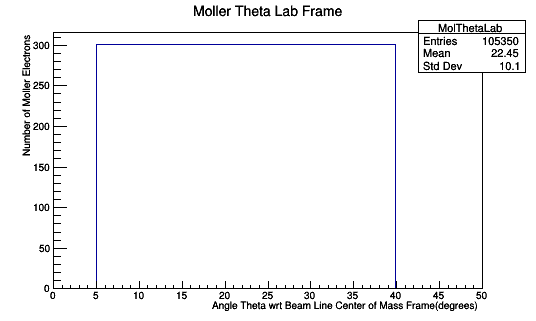
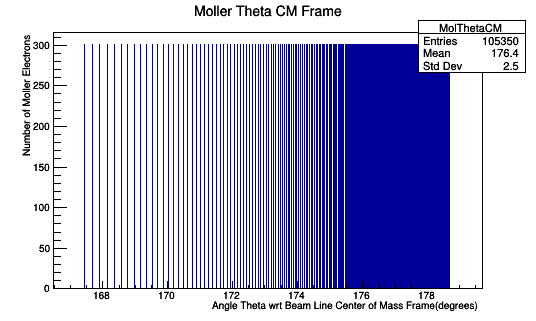
Applying the weight
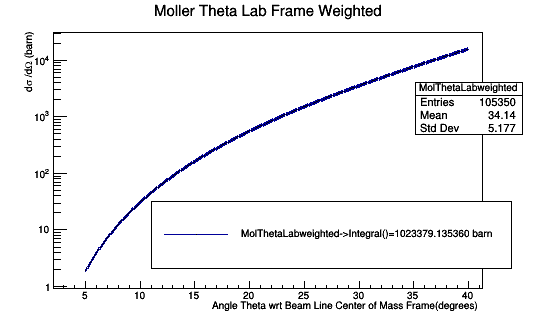
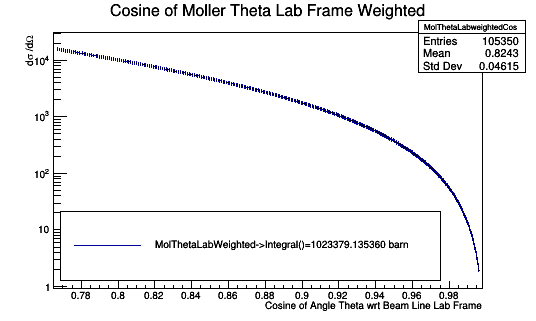
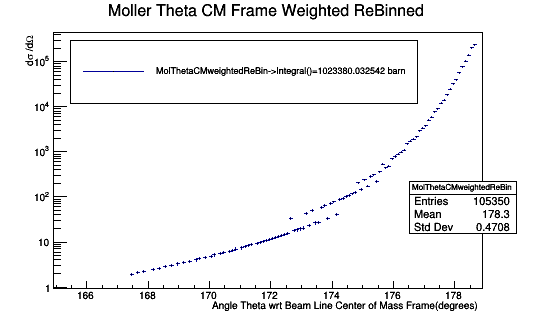
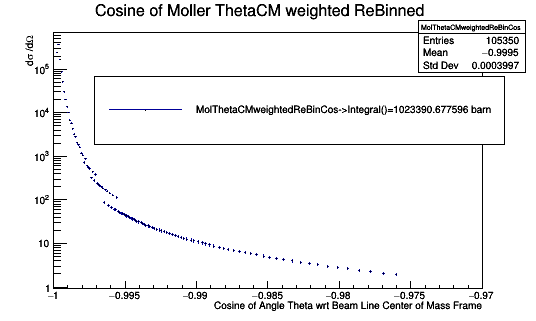
Looking at the angles and the associated weight, we can find the sums
Once_Angles_and_weight=3399.930890560805437
Total_Angles_and_weight=1023379.198058736044914
Checking with Mathematica
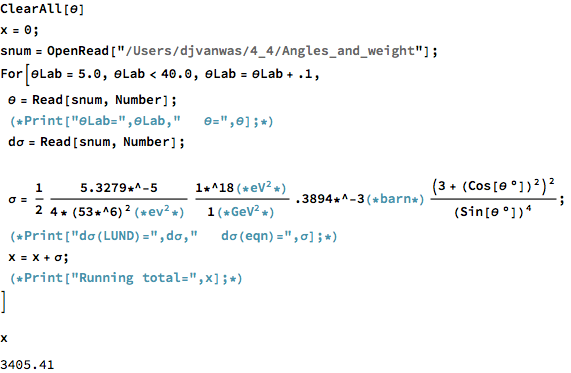
"Integrating" with Cosine term
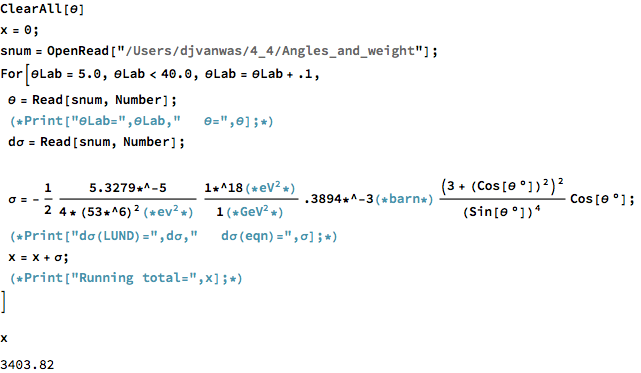
Finding the Cross Section

Performing a Riemann sum for [math]-30^{\circ} \lt \phi \lt 30^{\circ}[/math]
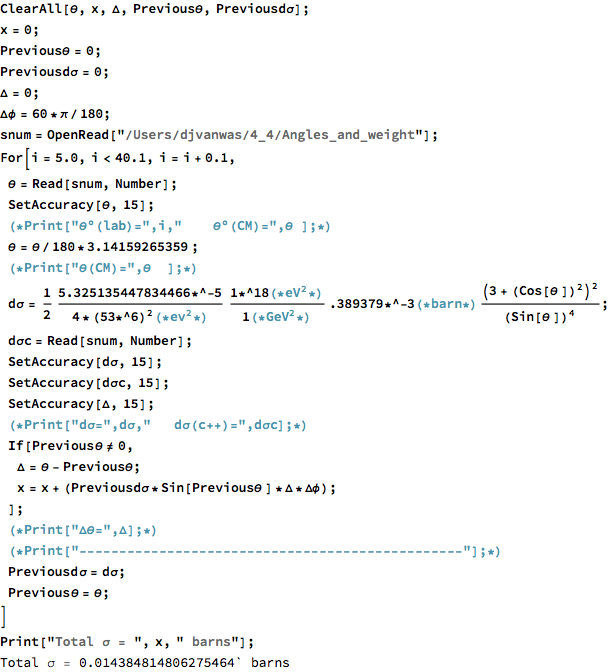
The cross section should be equal between both frames since the number of particles is an invariant. The differential cross section must differ between frames since the solid angle does vary.
[math]\sigma_{(CM)}=\sigma{(Lab)}[/math]
[math]\frac{d\sigma}{d\Omega}_{(CM)} d\Omega_{(CM)}=\frac{d\sigma}{d\Omega}_{(Lab)} d\Omega_{(Lab)}[/math]
[math]\frac{d\sigma}{d\Omega}_{(CM)} \sin \theta_{(CM)}\ d\theta_{(CM)}\ d\phi=\frac{d\sigma}{d\Omega}_{(Lab)} \sin \theta_{(Lab)}\ d\theta_{(Lab)}\ d\phi[/math]
[math]\rightarrow \frac{d\sigma}{d\Omega}_{(Lab)}=\frac{d\sigma}{d\Omega}_{(CM)} \frac{\sin \theta_{(CM)}\ d\theta_{(CM)}\ d\phi}{ \sin \theta_{(Lab)}\ d\theta_{(Lab)}\ d\phi}[/math]
[math]\rightarrow d\sigma_{(Lab)}=\frac{d\sigma}{d\Omega}_{(CM)} \frac{\sin \theta_{(CM)}\ d\theta_{(CM)}\ d\phi}{ \sin \theta_{(Lab)}\ d\theta_{(Lab)}\ d\phi}\sin \theta_{(Lab)} d\theta_{(Lab)}\ d\phi[/math]
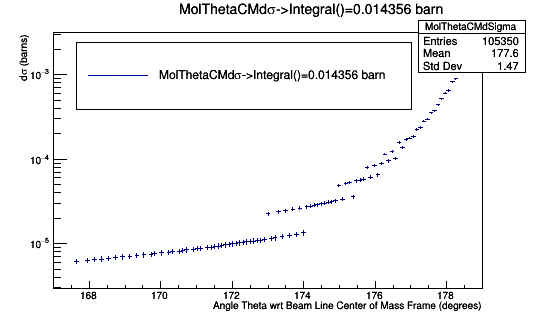
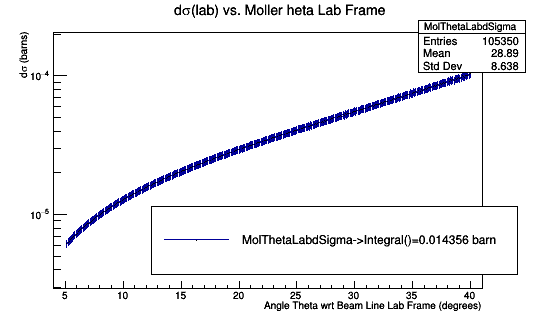
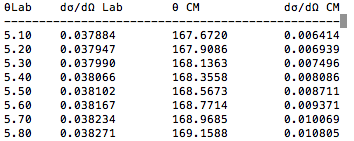

Adjust for DC Sector 1 Limits
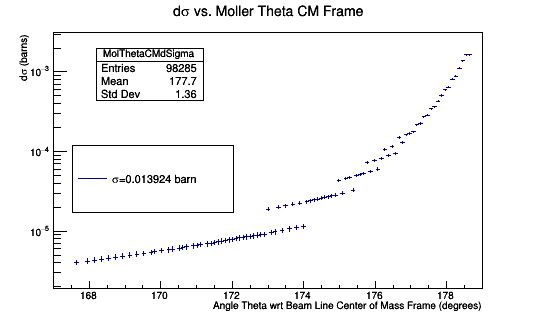
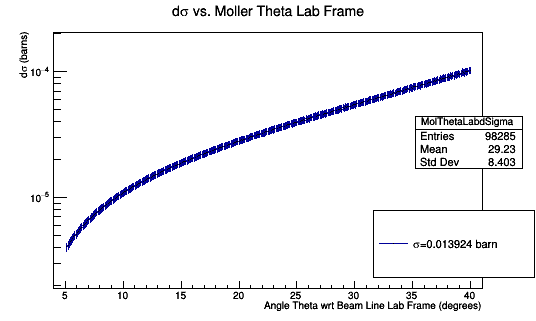
GEMC Cross Section
Only taking GEMC hits in Sector 1 with Track ID of the mother of the FP equal to zero:
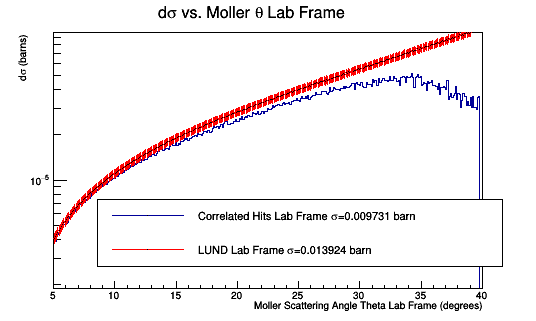 [math]\frac{0.009731\ barn}{0.013924\ barn}=70\%[/math]Efficiency
[math]\frac{0.009731\ barn}{0.013924\ barn}=70\%[/math]Efficiency
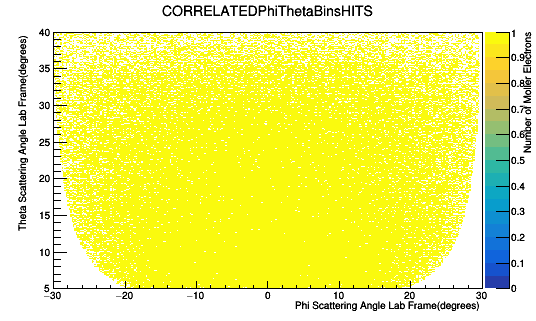
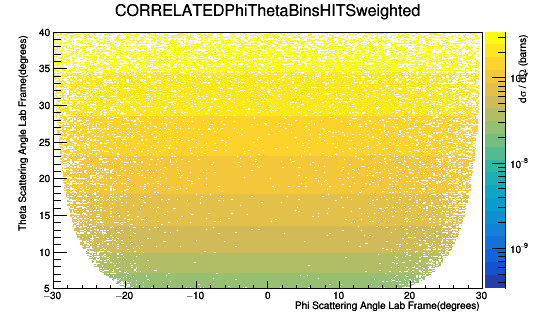
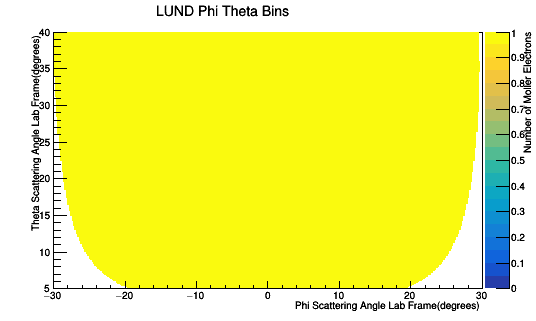
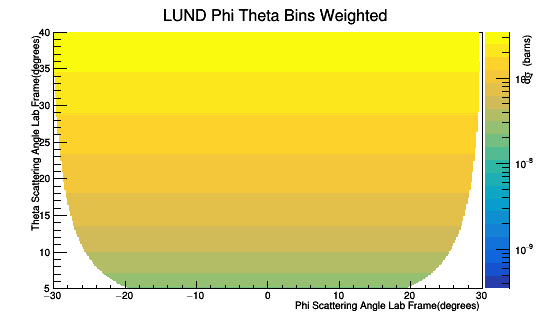
Taking GEMC hits with ANY Track ID of the mother of the FP :
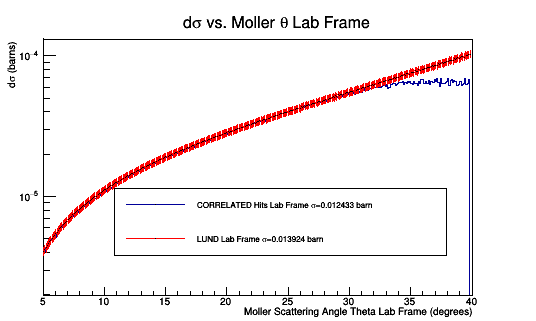 [math]\frac{0.012433\ barn}{0.013924\ barn}=90\%[/math]Efficiency
[math]\frac{0.012433\ barn}{0.013924\ barn}=90\%[/math]Efficiency
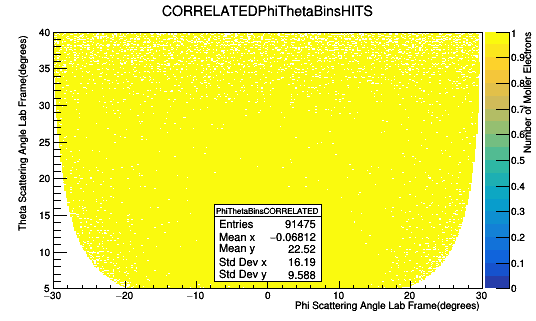
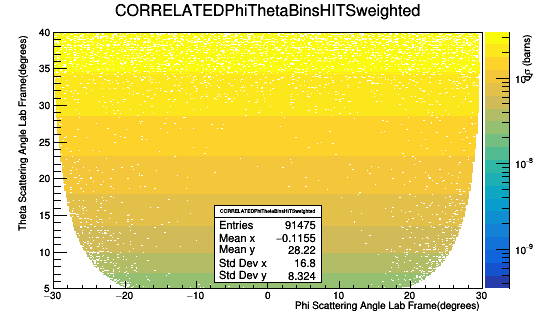
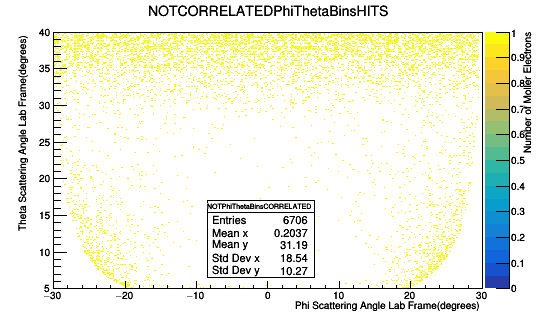
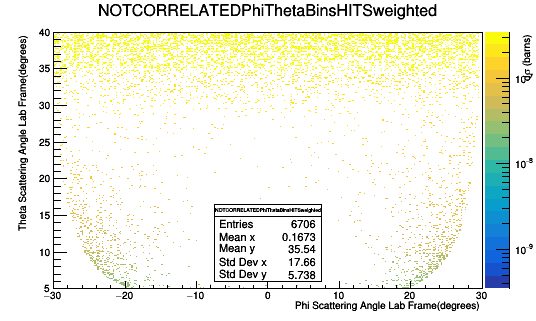


Using the Cross Section
If we make the assumption that the beam of incoming electrons is a flux over an area for a given time,
[math]N_{incident}=\Phi\ A_{beam}\ t_{run} \rightarrow dN_{incident}=\Phi\ dA_{beam}\ t_{run}\rightarrow\ \frac{dN_{incident}}{ dA_{beam}}=\Phi\ t_{run}[/math]
Using the definition of the differential cross section:
[math]\frac{d\sigma}{d\Omega}\equiv \frac{ \Biggl(\frac{dN_{scattered}}{d\Omega} \Biggr)}{\Biggl(\frac{dN_{incident}}{dA}\Biggr)}\rightarrow \frac{d\sigma}{d\Omega}\Biggl(\frac{dN_{incident}}{dA}\Biggr)=\Biggl(\frac{dN_{scattered}}{d\Omega} \Biggr)[/math]
Substituting using the flux
[math] \frac{d\sigma}{d\Omega}\Biggl(\frac{dN_{incident}}{dA}\Biggr)=\Biggl(\frac{dN_{scattered}}{d\Omega} \Biggr)\rightarrow \frac{d\sigma}{d\Omega}\Phi\ t_{run}=\Biggl(\frac{dN_{scattered}}{d\Omega} \Biggr)[/math]
[math]\rightarrow dN_{scattered}= \frac{d\sigma}{d\Omega}\Phi d\Omega= \frac{d\sigma}{d\Omega}\Phi\ t_{run}\ \sin \theta\ d\theta\ d\phi[/math]
Since the differential cross section is known in the Center of Mass frame of reference, but measurements are taken in the Lab Frame, a transformation must occur.
[math]\rightarrow dN_{scattered}= \frac{d\sigma}{d\Omega_{Lab}}\Phi\ t\ \sin \theta_{Lab}\ d\theta_{Lab}\ d\phi_{Lab}[/math]
[math]\frac{d\sigma}{d\Omega_{Lab}}\sin \theta_{Lab}\ d\theta_{Lab}\ d\phi_{Lab}=\frac{d\sigma}{d\Omega_{CM}}\sin \theta_{CM}\ d\theta_{CM}\ d\phi_{CM}[/math]
[math]\frac{d\sigma}{d\Omega_{Lab}}=\frac{d\sigma}{d\Omega_{CM}}\frac{\sin \theta_{CM}\ d\theta_{CM}\ d\phi_{CM}}{\sin \theta_{Lab}\ d\theta_{Lab}\ d\phi_{Lab}}[/math]
[math]\rightarrow dN_{scattered}=\frac{d\sigma}{d\Omega_{CM}}\frac{\sin \theta_{CM}\ d\theta_{CM}\ d\phi_{CM}}{\sin \theta_{Lab}\ d\theta_{Lab}\ d\phi_{Lab}}\Phi\ t_{run}\ \sin \theta_{Lab}\ d\theta_{Lab}\ d\phi_{Lab}[/math]
If we divide both sides by time
[math]\rightarrow \frac{dN_{scattered}}{t_{run}}=\frac{d\sigma}{d\Omega_{CM}}\frac{\sin \theta_{CM}\ d\theta_{CM}\ d\phi_{CM}}{\sin \theta_{Lab}\ d\theta_{Lab}\ d\phi_{Lab}}\Phi \sin \theta_{Lab}\ d\theta_{Lab}\ d\phi_{Lab}[/math]
[math]\rightarrow \frac{dN_{scattered}}{t_{run}}=\frac{d\sigma}{d\Omega_{CM}}\frac{\sin \theta_{CM}\ d\theta_{CM}\ d\phi_{CM}}{\sin \theta_{Lab}\ d\theta_{Lab}\ d\phi_{Lab}}\frac{N_{incident}}{t_{run}} \sin \theta_{Lab}\ d\theta_{Lab}\ d\phi_{Lab}[/math]
[math]\rightarrow \frac{dN_{scattered}}{N_{incident}}=d\sigma_{Lab}[/math]
Number of Hits on Wires
Not all 1st hits are on layer 1. Using the correlated theoretical wire number associated with the LUND Theta and Phi values:
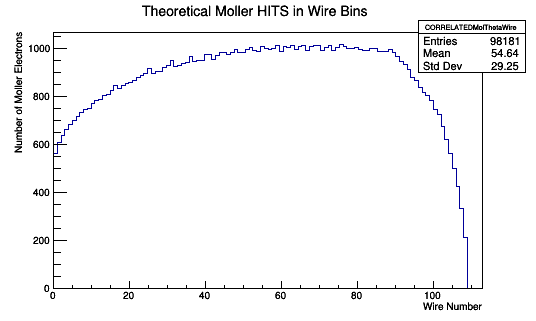
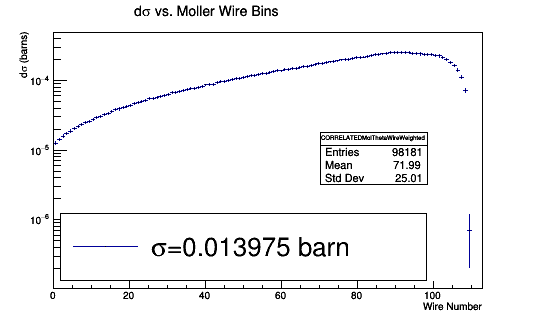
The theoretical model has events which are detected by physically impossible valued wires. If we limit the lowest wire value to 0.5 and the highest to less than 112.5
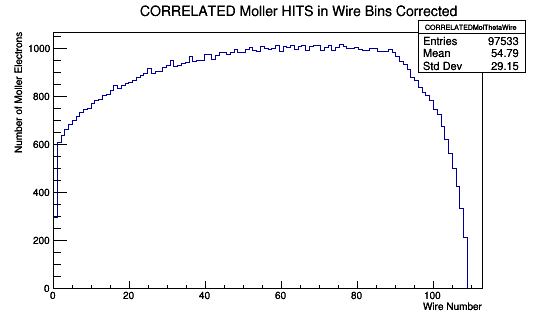
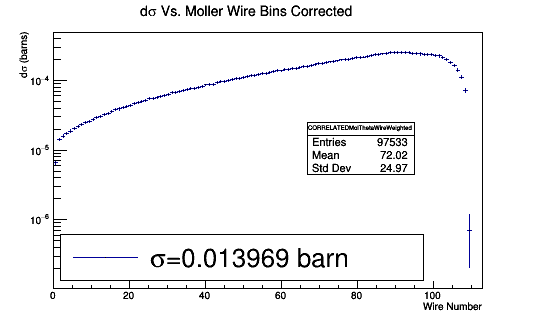
Using the histogram integral function we find the sum of the values for the wire 1 bin. Collecting the individual [math]d\sigma[/math] for each theoretical and physical hits on DC wires.
Wire 1 Based Actual Hits σ=0.00001287 barn
File:Wire1 AcutalHITS.text
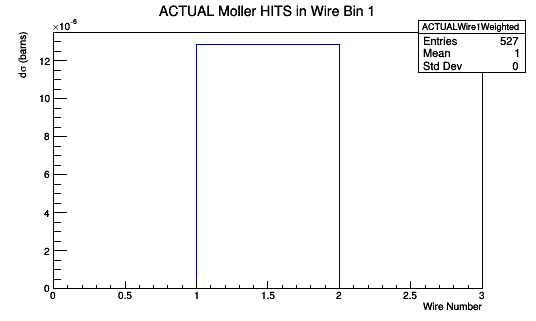
σ=0.000013 barn
[math]\frac{N_{scattered}}{t_{run}}=0.00001287\ \Phi_{nA}[/math]
[math]\frac{N_{scattered}}{0.00001287\ \Phi_{nA}}=t_{run}[/math]
For 1 hit on wire 1:
[math]\begin{cases}
3.12\times 10^{11}\ \frac{1}{s}=\Phi_{50nA}\rightarrow t=249ns\\
4.68\times 10^{11}\ \frac{1}{s}=\Phi_{75nA}\rightarrow t=166ns\\
6.24\times 10^{11}\ \frac{1}{s}=\Phi_{100nA}\rightarrow t=125ns\\
7.80\times 10^{11}\ \frac{1}{s}=\Phi_{125nA}\rightarrow t=99.6ns\\
9.36\times 10^{11}\ \frac{1}{s}=\Phi_{150nA}\rightarrow t=83ns
\end{cases}[/math]
Wire 1 Based Correlated Hits σ=0.00001345 barn
File:Wire1 CorrelatedHITS.text
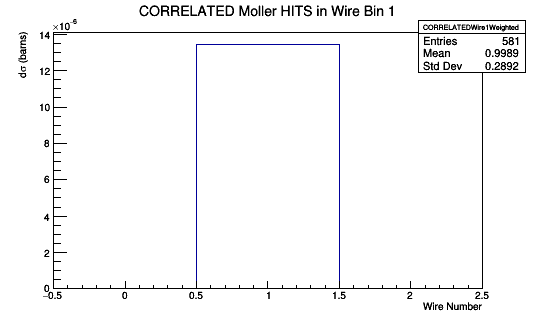
σ=0.000013 barn
[math]\frac{N_{scattered}}{t_{run}}=0.00001345\ \Phi_{nA}[/math]
[math]\frac{N_{scattered}}{0.00001345\ \Phi_{nA}}=t_{run}[/math]
For 1 hit on wire 1:
[math]\begin{cases}
3.12\times 10^{11}\ \frac{1}{s}=\Phi_{50nA}\rightarrow t=238ns\\
4.68\times 10^{11}\ \frac{1}{s}=\Phi_{75nA}\rightarrow t=159ns\\
6.24\times 10^{11}\ \frac{1}{s}=\Phi_{100nA}\rightarrow t=119ns\\
7.80\times 10^{11}\ \frac{1}{s}=\Phi_{125nA}\rightarrow t=95.3ns\\
9.36\times 10^{11}\ \frac{1}{s}=\Phi_{150nA}\rightarrow t=79.4ns
\end{cases}[/math]
Wire 1 Based Theoretical Hits σ=0.00001387 barn
File:Wire1 Based Angles and weight.txt
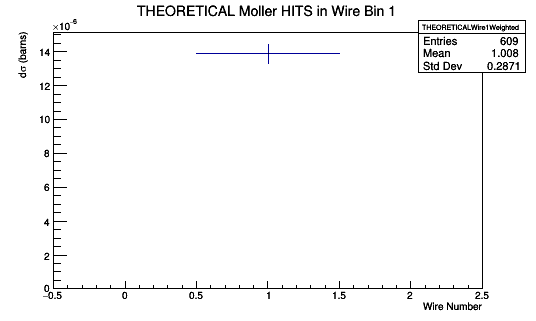
σ=0.000014 barn
[math]\frac{N_{scattered}}{t_{run}}=0.00001387\ \Phi_{nA}[/math]
[math]\frac{N_{scattered}}{0.00001387\ \Phi_{nA}}=t_{run}[/math]
For 1 hit on wire 1:
[math]\begin{cases}
3.12\times 10^{11}\ \frac{1}{s}=\Phi_{50nA}\rightarrow t=231ns\\
4.68\times 10^{11}\ \frac{1}{s}=\Phi_{75nA}\rightarrow t=154ns\\
6.24\times 10^{11}\ \frac{1}{s}=\Phi_{100nA}\rightarrow t=116ns\\
7.80\times 10^{11}\ \frac{1}{s}=\Phi_{125nA}\rightarrow t=92.4ns\\
9.36\times 10^{11}\ \frac{1}{s}=\Phi_{150nA}\rightarrow t=77.0ns
\end{cases}[/math]
Occupancy
LH2_NOSol_0Tor_11GeV_IsotropicPhi_v2_6_ShieldOut
Run
./BUILD_GEMC_SIMULATION.sh
DVMacro
Clas12Mon
Create hipo file
Move hipo file to clas12mon folder
mv LH2_NOSol_0Tor_11GeV_IsotropicPhi_v2_6_ShieldOut.hipo ~/clas12mon
Run monitor program
./README
Load hipo file
"Press H for hipo"
"Press play"
"Switch to
For [math]5^{\circ}\gt \theta\lt 40^{\circ}\ -30^{\circ}\gt \phi\lt 30^{\circ}[/math]
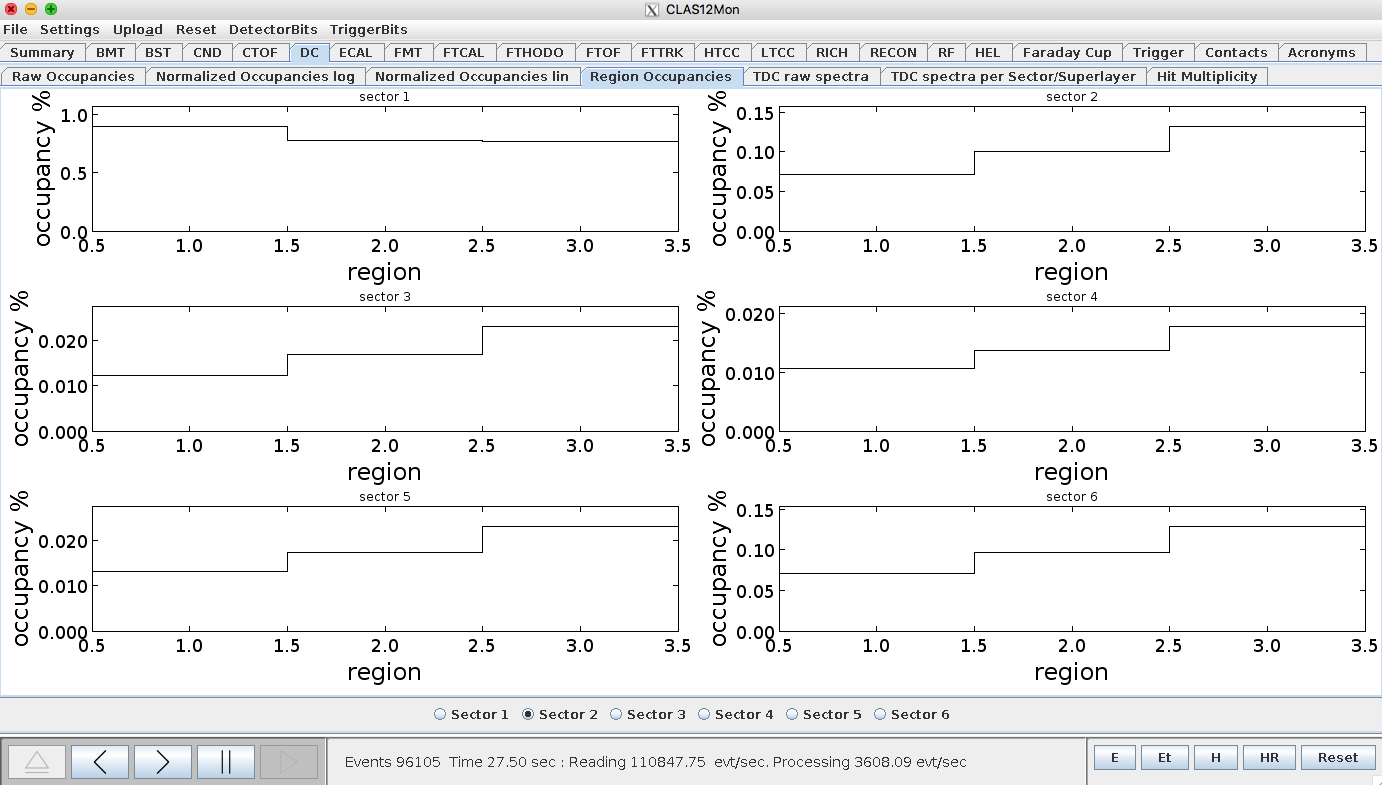
FOR DC Limits
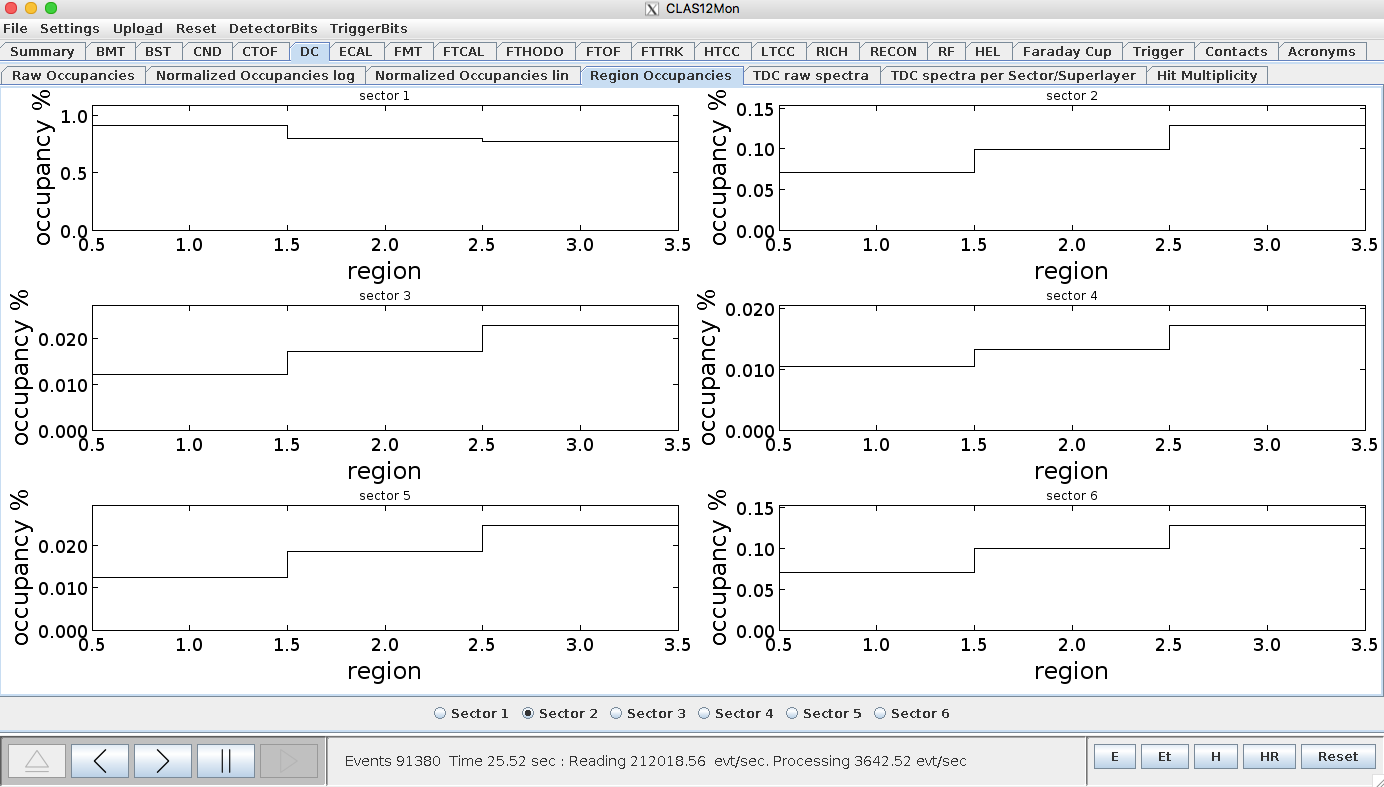
Calculating
[math]N_0=\Delta t \cdot R_{events}=\Delta t \cdot \frac{N_{events}}{t_{simulated}}=250\times 10^{-9}\ s \cdot \frac{98181}{9.3\times 10^{-6}\ s}=2639[/math]
[math]Occupancy=\frac{N_{hits}}{N_0}=\frac{N_{hits}}{\Delta t \cdot R_{events}}=\frac{t_{simulated}\cdot N_{hits}}{N_{events}\cdot \Delta t}=[/math]


































